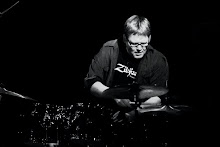I would like to thank Mike Yates for the suggestion for this blog. He asked to explain about getting different sounds on the drums and incorporating them into one's playing. This is a subject near and dear to my heart! Ever since I started playing, I have always looked for alternate sounds on the instrument. Like a lot of things in music, I think the more time we spend looking for sounds, the more we'll find them and be able to integrate them into the things we do. I might be so bold as to say I feel it's a drummer's responsibility to keep searching for sounds the instrument will reveal. If we spend time with the instrument, it will start to show us it's secrets.
I'll now discuss some of the ways I think about colours on the drums.
The way I see it, we can create unorthodox sounds in 3 basic ways.
1. What we're hitting the drums (or any sound source) with.
2. Treating or preparing the drums (or sound source).
3. Using unusual sound sources that aren't normally associated with the drum set.
Here's a little solo I improvised today. Let's look at it and then I'll discuss the types of sounds and how I achieved them. Oh, before I forget, don't feel that all your sound source ideas have to be completely original. When I can remember who I got certain ideas from, I will give them credit.
Phew! Not a particularly flattering camera angle.
Anyway, I started off with a toy noisemaker form the dollar store. You can experiment with holding toys like this against the drums to make them resonate.
I then was flicking the drums with my fingertips and rubbing my nails against the head surface. I've never really used my nails so much (although I do a lot of b.s. hand drumming) and I got the concept from a Don Vickery clinic.
Next some playing around with a coat hanger on the cymbal ( Other things I've used would include chopsticks and plastic cutlery) while I use a brush container in the left hand. Then I join in with a tambouring played with my left foot. That's a case where I'm playing a very standard thing , but it sounds more exotic because it's a different sound source than hi-hat. It's important to rest your foot on the tambourine and strike it with the heel of your foot. I copped this from Jeff Ballard. On to brushes/hand. Also I like playing with the snare mechanism to create effects and there's my bike bell! I've always thought cymbal stands use up a lot of space and if you can find something to hang/attach on them, it's always a good thing. I like to try to hear what all the parts of the drums and cymbals sound like. We usually view hitting the wing nut of the cymbal stand as a mistake but it's a great sound! ( Thank you Guy Nadon!) Also different parts of the hi-hat stand have different pitches (Sherman Ferguson).
A simple way of "preparing" the drum set is to place something on the drum surface to limit it's resonance. In this case I've used some splash cymbals but blankets, towel etc. work well too.
Different left foot sound source (bike horn). Back to the toy noise maker. and ended with getting harmonics out of a cymbal (hold the stick like a pencil and rub the tip across the cymbal). The great Montreal drummer Pierre Tanguay taught me that trick.
So, there's lots of sounds. Get experimenting and try to surprise yourself.

Man, why is no one posting on your blog?? That was SWEET!! Major commendations for this treasure trove of great ideas.
ReplyDeleteThanks for the rest of the blog, too! I read you and Four-on-the-Floor pretty much daily.
Thanks Toby!
ReplyDelete